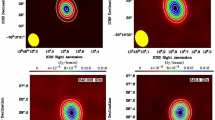Abstract
Results of quasi-simultaneous SWIFT and RTT-150 observations for the X-ray nova SWIFT J174510.8-262411 in May–June 2013 at the decaying phase of its outburst are presented. It is shown that the nova spectrum can be fitted in a very wide energy range (from the infrared z and i bands to hard X-rays) by a single power law attenuated due to absorption but without any traces of the presence of a soft (blackbody) component. The presence of such a component is suggested by the generally accepted models of disk accretion onto a black hole in a binary system. The observation of a single power-law spectrum may imply that synchrotron radiation from the source’s relativistic jets makes a major contribution to its flux or that the accretion disk is everywhere hot, optically thin, and radiates nonthermally.
Similar content being viewed by others
References
R. A. Arnaud, in Proceedings of the ASP Conference on Astronomical Data Analysis Software and Systems V, Ed. by G. Jacoby and J. Barnes (ASP, San Francisco, 1996), Vol. 101, p. 17.
S. D. Barthelmy, L. M. Barbier, J. R. Cummings, et al., Space Sci. Rev. 120, 143 (2005).
T. Belloni, M. Cadolle Bel, P. Casella, et al., Astron. Telegram 4450 (2012).
D. N. Burrows, J. E. Hill, J. A. Nousek, et al., Space Sci. Rev. 120, 165 (2005).
A. M. Cherepashchuk, Phys. Usp. 46, 335 (2003).
S. Corbel, M. Coriat, C. Brocksopp, A. K. Tzioumis, R. P. Fender, et al., Mon. Not. R. Astron. Soc. 428, 2500 (2013).
M. Coriat, S. Corbel, M. M. Buxton, C. D. Bailyn, J. A. Tomsick, et al., Mon. Not. R. Astron. Soc. 400, 123 (2009).
J. R. Cummings, C. Gronwall, D. Grupe, et al., GCN Circ. 13774 (2012a).
J. R. Cummings, S. D. Barthelmy, W. H. Baumgartner, et al., GCN Circ. 13775 (2012b).
B. T. Draine, Ann. Rev. Astron. Astrophys. 41, 241 (2003).
A. A. Esin, E. Kuulkers, J. E. McClintock, and R. Narayan, Astrophys. J. 532, 1069 (2000).
P. A. Evans, R. Willingale, J. P. Osborne, et al., Astron. Astrophys. 519, A102 (2010).
P. Gandhi, K. Makishima, M. Durant, A. C. Fabian, V. S. Dhillon, et al., Mon. Not. R. Astron. Soc. 390, L29 (2008).
N. Gehrels, G. Chincarini, P. Giommi, et al., Astrophys. J. 611, 1005 (2004).
S. A. Grebenev, A. V. Prosvetov, and R. A. Sunyaev, Astron. Lett. 39, 367 (2013).
S. A. Grebenev and R. A. Sunyaev, Astron. Telegram 4401 (2012).
R. I. Hynes, C. A. Haswell, W. Cui, C. R. Shrader, K. O’Brien, et al., Mon. Not. R. Astron. Soc. 345, 292 (2003).
G. Kanbach, C. Straubmeier, H. C. Spruit, and T. Belloni, Nature 414, 180 (2001).
E. Kuulkers, J. Chenevez, J. Alfonso-Garzon, et al., Astron. Telegram 4804 (2013).
R. Morrison and D. McCammon, Astrophys. J. 270, 119 (1983).
B. Sbarufatti, J. A. Kennea, M. C. Stroh, D. N. Burrows, P. A. Evans, et al., Astron. Telegram 4782 (2013).
N. I. Shakura and R. A. Sunyaev, Astron. Astrophys. 24, 337 (1973).
S. L. Shapiro, A. P. Lightman, and D. M. Eardley, Astrophys. J. 204, 187 (1976).
V. F. Suleimanov, G. V. Lipunova, and N. I. Shakura, Astron. Astrophys. 491, 267 (2008).
R. A. Sunyaev and L. G. Titarshuk, Astron. Astrophys. 86, 121 (1980).
J. A. Tomsick, E. Kalemci, P. Kaaret, S. Markoff, S. Corbel, et al., Astrophys. J. 680, 593 (2008).
J. A. Tomsick, M. DelSanto, and T. Belloni, Astron. Telegram 4393 (2012).
I. Vovk, C. Ferrigno, E. Drave, et al., Astron. Telegram 4381 (2012).
S. D. Vrtilek, J. C. Raymond, M. R. Garcia, F. Verbunt, and G. Hasinger, Astron. Astrophys. 235, 162 (1990).
Author information
Authors and Affiliations
Corresponding author
Additional information
Original Russian Text © S.A. Grebenev, A.V. Prosvetov, R.A. Burenin, 2014, published in Pis’ma v Astronomicheskiı Zhurnal, 2014, Vol. 40, No. 4, pp. 198–204.
Rights and permissions
About this article
Cite this article
Grebenev, S.A., Prosvetov, A.V. & Burenin, R.A. Broadband spectrum of the X-ray nova SWIFT J174510.8-262411 at the decaying phase of its outburst. Astron. Lett. 40, 171–176 (2014). https://doi.org/10.1134/S106377371404001X
Received:
Published:
Issue Date:
DOI: https://doi.org/10.1134/S106377371404001X



